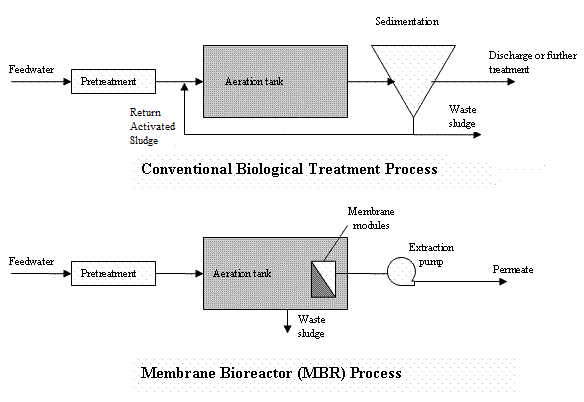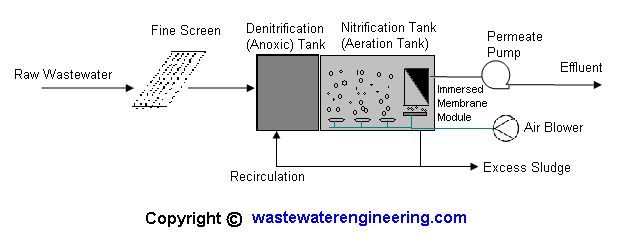MBR - Membrane BioReactors for Wastewater Treatment
MBR - Membrane Bioreactor
Systems are no longer viewed as a novel process as it is used
more and more in wastewater treatment applications all over the
world.
Wastewater represents a water resource and its reuse can significantly
reduce the demand for water supply. Membrane Bioreactor is an
effective and economic treatment process for water reuse and reclamation.
Advanced membrane technology development includes membrane bioreactors
and multibarrier reclamation processes using dual membrane stages.
A common water reclamation process is by integrating MBR and RO
(Reverse Osmosis) to produce high quality product water for reuse.
Compared with conventional activated sludge system, the membrane
bioreactor system is much simpler, as shown below.

We supply a range of MBR Systems and modules to satisfy our customers'
needs. By membrane configurations they can be classified as:
- Hollow Fibre MBR
- Evoqua Memcor mbr module
- Zennon ZeeWeed mbr module
- Mitsubishi Rayon membrane module
- Citic Memstar mbr module
- Plate and Frame MBR (Flat Sheet Membranes)
- Kubota mbr
- Hitachi membrane module - obselete and needs to use other compatible replacement modules e.g. WTA UNISOL MYTEX Modules
- Toray mbr module
- WTA UNISOL Mytex flat sheet backwashable membranes
- Huber
- Microdyn-Nadir/Mann+Hummel BioCel Membranes
By process configurations the MBR systems can be classified as:
- Submerged MBR
- Side Stream MBR (or external membrane)
For submerged MBR systems the Trans-membrane pressure is usually
less than 0.5 bar (under vacuum pressure). The vacuum required
for the mbr is usually from suctions pumps. Various types of pumps
including centrifgal pump, gear pump, screw pump and helical rotor
pumps can be used for this vacuum pumping purpose.
While for external membrane systems TMP of 1~4 bar is usual.
One typical MBR Process Flow Diagram is shown below. Raw wastewater
usually pass through coarse screens and fine screens to remove
particles that might possibly affect the downstream equipment
and process. Membrane module can be immersed in the aeration tank
itself or in a seprate membrane tank. Recirculation is utilized
if denitrication is required for nitrogen nutrient removal.

Raw wastewater -> Fine Screens -> Denitrification ->
Aeration -> Filtration -> Permeate
MBR system's advantages include the following:
- almost complete solids and bacteria (Giardia and Crypto) removal;
- high effluent quality; modular design with good expandability;
- robustness in recovery resistant to upsets due to shock loadings
or peak and fluctuating flows;
- sludge age or SRT (solids retention time) and hydraulic residence
time (HRT) are controlled separately;
- less odor;
- sophisticated but yet simple controls.
Some of the disadvantages of MBR technology are:
- membrane fouling
- higher energy consumption to overcome trans-membrane resistance
and to prevent fouling using aeration etc
- high cost of membranes
Wastewater Engineering Group's expertise in Membrane Bioreactor
Systems range from treatability studies to retrofit of existing
systems, we have vast design, operating experiences in MBR applications
for sewage and industrial wastewater treatment. |